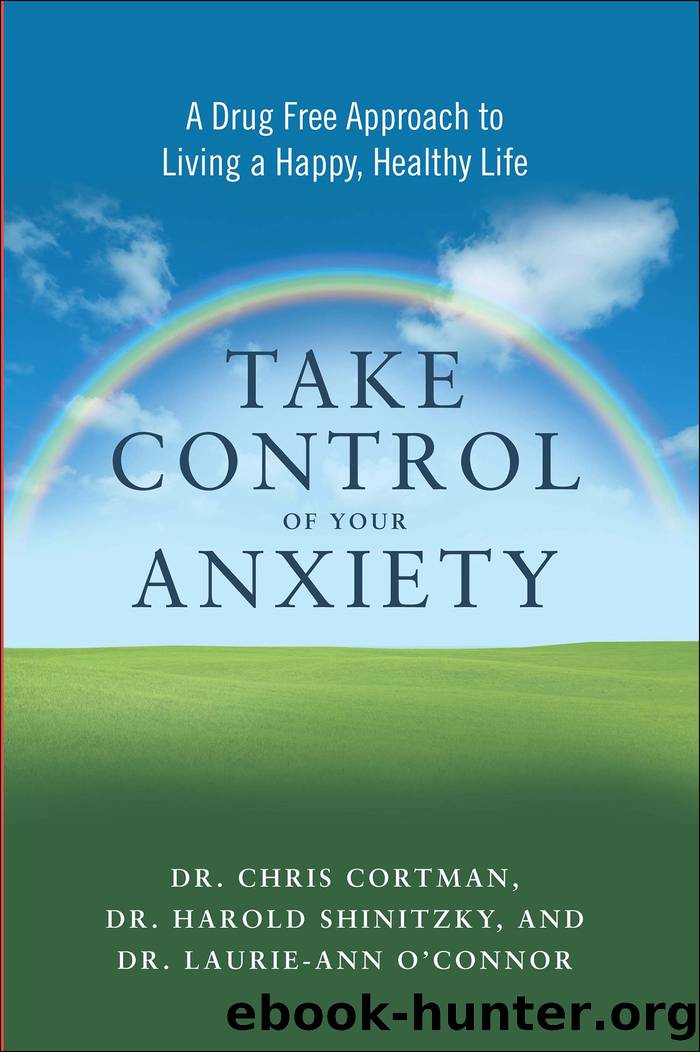Take Control of Your Anxiety by Christopher Cortman & Dr. Harold Shinitzky & Dr. Laurie-Ann O’Connor

Author:Christopher Cortman & Dr. Harold Shinitzky & Dr. Laurie-Ann O’Connor
Language: eng
Format: epub
Publisher: Red Wheel Weiser
Published: 2015-09-14T16:00:00+00:00
Power Tool #6: Relaxation, Yoga, and Mindfulness
Rest and relaxation (R&R); itâs what you work for, save for, live for. But do you really know how to relax? Chances are, you require a substance (alcohol), or perhaps a destination (the beach), or more likely, a combination thereof (a piña colada on Siesta Beach) to help launch you into relaxation mode. But what if you could learn to relaxâreally relaxâin your own home? Every day? Without the chemicals?
I know, I sound suspiciously close to an infomercial that will say something like, âWell now you can!â And soon after, Iâd throw in some ginsu knives to seal the deal. Take heart, this is not an infomercial, its scientific research. And the research says this: if you can give up 15 minutes of your day to practice relaxation (of your choice), you might see the following results: a significant reduction in anxiety, blood pressure, physical pain, tension headaches, and cortisol (the stress hormone). You will notice an increase in sleep quantity and quality, a reduction in the likelihood of suffering from cognitive decline (dementia), depression, and perfectionism. Also, presumably a significant improvement in sexual function. With all of this, who needs knives?
Relaxation retrains your nervous system to respond with calmness, instead of igniting the stress response and creating anxiety. The daily practice, of course, guarantees that you become proficient at relaxing, so much so that it becomes your initial response, your first line of defense. Imagine walking around your life in relaxation mode, instead of chronically anxious and one stressor away form a major melt down!
But how does one relax with the myriad issues present in the life of John Q. Public and his lovely wife Jane? The answer, of course, is to find a relaxation exercise that works for you. Letâs explore a few different options among the many relaxation exercises available. We can start with a Harvard-trained psychologist named Herbert Benson, who created a technique called the relaxation response. The idea was to help people to respirate deeply enough to reduce their breathing rate, pulse, and even cognitions. His technique caught on quickly and spread like wildfire.
Benson defined relaxation as âa state of decreased Psycho-physiological arousal: a calming state.â7 An excerpt of Bensonâs method is included below:
Sit quietly in a comfortable position.
Close your eyes.
Relax your muscles, progressing from your feet to your calves, thighs, abdomen, shoulders, head, and neck.
Breathe slowly and naturally. As you do, repeat the word âOneâ silently to yourself as you exhale.
Assume a passive attitude. Donât worry about how well youâre doing. When other thoughts come to mind, simply say to yourself, âOh well,â and gently return to your repetition.
Continue for 10 to 20 minutes.
Do not stand immediately. Continue sitting quietly for a minute or so, allowing other thoughts to return. Then open your eyes and sit for another minute before rising.
Practice the technique once or twice daily. Good times to do so are before breakfast and before dinner.8
Download
This site does not store any files on its server. We only index and link to content provided by other sites. Please contact the content providers to delete copyright contents if any and email us, we'll remove relevant links or contents immediately.
Rewire Your Anxious Brain by Catherine M. Pittman(17589)
The Code Book by Simon Singh(2209)
The Wrong McElroy by KL Hughes(2009)
How to Be Yourself by Ellen Hendriksen(1936)
No Worries by Sarah Edelman(1854)
Life After Darkness by Michelle Knight(1526)
I Really Didn't Think This Through by Beth Evans(1403)
Anxious for Nothing by Max Lucado(1400)
Unfuck Your Brain: Using Science to Get Over Anxiety, Depression, Anger, Freak-Outs, and Triggers by Faith G Harper(1384)
The Velvet Rage by Alan Downs(1373)
The Anxiety Workbook by Arlin Cuncic MA(1341)
First, We Make the Beast Beautiful by Sarah Wilson(1257)
How Not to Worry by Paul McGee(1196)
You Can Do All Things by Kate Allan(1172)
Free Yourself from Fears by Joseph O'Connor(1156)
The Worry Trick by David A Carbonell(1149)
Coping with Anxiety by Edmund Bourne & Lorna Garano(1112)
Need by Unknown(1095)
The Sensory Child Gets Organized by Carolyn Dalgliesh(1060)
